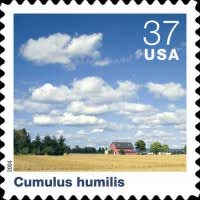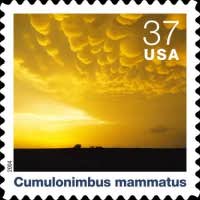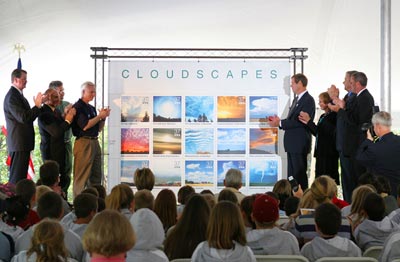
 |
As Clouds Roll By
 Every October, the U.S. Postal Service likes to issue stamps of interest to children, along with teacher kits for use in the classroom.
Every October, the U.S. Postal Service likes to issue stamps of interest to children, along with teacher kits for use in the classroom.In the past, that's included "creepy-crawlies" like insects and reptiles, but this year's subject, "Cloudscapes," is a little more scientific.
The 15-stamp sheet was issued Monday, Oct. 4, at the Blue Hill Observatory just south of Boston.
For this issue, the USPS forged an alliance with The Weather Channel, the American Meteorological Society and the National Oceanic and Atmospheric Administration's National Weather Service.
The Postal Service hopes many of the nation's television meteorologists will highlight the stamps during their forecasts, and incorporate the Cloudscapes stamps into their community outreach initiatives. The Cloudscapes stamps also will be included in the National Weather Service's outreach programs.
"With these spectacular images, we've captured the wonder of nature and the power of the world's weather to shape our lives and our land," said William Johnstone of the Postal Service. "These cloudscapes are beautiful reminders of our ties to the larger environment we live in - an environment of air and water that sustains us all."
 The cloud types shown on the stamp pane are: Cirrus radiatus, Cirrostratus fibratus, Cirrocumulus undulatus, Cumulonimbus mammatus, Cumulonimbus incus, Altocumulus stratiformis, Altostratus translucidus, Altocumulus undulatus, Altocumulus castellanus, Altocumulus lenticularis, Stratocumulus undulatus, Stratus opacus, Cumulus humilis, Cumulus congestus and Cumulonimbus with tornado.
The cloud types shown on the stamp pane are: Cirrus radiatus, Cirrostratus fibratus, Cirrocumulus undulatus, Cumulonimbus mammatus, Cumulonimbus incus, Altocumulus stratiformis, Altostratus translucidus, Altocumulus undulatus, Altocumulus castellanus, Altocumulus lenticularis, Stratocumulus undulatus, Stratus opacus, Cumulus humilis, Cumulus congestus and Cumulonimbus with tornado. Clouds develop when moist air cools to its dew point by rising to a higher altitude or by moving over a cooler surface. Water vapor in the air then condenses in liquid or frozen form around minute particles such as pollen or dust. The shapes and altitudes of clouds, as well as the sequence in which they develop, are a sign of changing weather patterns and aid in forecasts. The prefixes "cirro" and "alto" distinguish high and middle-altitude clouds, respectively.
The five types of clouds that ride highest in the sky are on the top row of the sheet of self-adhesive 37-cent stamps, the ones in the middle atmosphere are on the middle row, and those closest to the ground on the bottom.
You don't get much closer to the ground than a tornado, as Edi Ann Otto of Osnabrock, N.D., knows.
"A tornado just happened to go by my farmstead one day, and I just happened to have a camera loaded, and started to take pictures after it went by," she told The Virtual Stamp Club.
One of her 1978 photographs of the tornado is the basis for the stamp in the bottom right corner of the sheet.
"They've been used, these tornado pictures, all over the world," Otto said, in articles, ads, even textbooks. The stamp is probably the biggest honor "or it could be the National Geographic double-page spread."
When she first took the photos, she entered them in another magazine's contest, and won "third place."
The stamp certainly beats that.
Audio Feature
